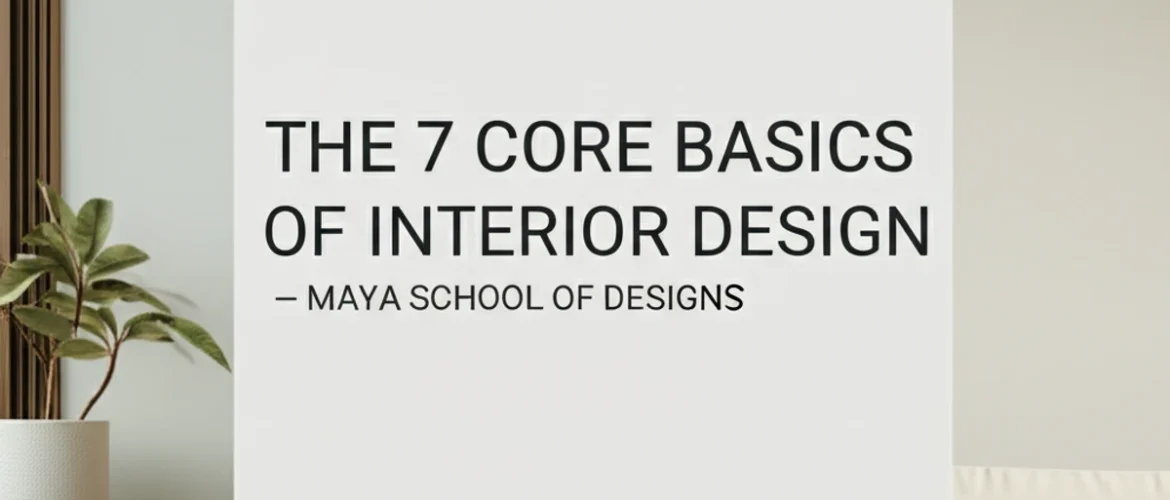Blog
Learn the 7 Core Basics of Interior Design – Maya School of Designs
- October 1, 2025
- Posted by: admin
- Category: Blog Interior Design

Learn the 7 Core Basics of Interior Design: Your Blueprint for Beautiful Interior Design Spaces
Ever stood in an empty room, a blank canvas stretching before you, and felt a dizzying mix of excitement and absolute overwhelm? You dream of transforming it into a sanctuary, a vibrant workspace, or a cozy family hub, but where do you even begin? The world of interior design, with its endless styles and trends, can seem like a beautiful, intricate puzzle with too many pieces.
But what if I told you there’s a secret language to design, a set of foundational principles that, once understood, unlock the power to create any space you envision? Just like a musician learns scales before composing a symphony, every aspiring designer needs to grasp the *interior design basics*. These aren’t just rules; they’re the building blocks of every stunning room you’ve ever admired. Today, we’re going to pull back the curtain on these 7 core basics, offering you a sneak peek into the kind of transformative learning you can experience at places like the Maya School of Designs. Get ready to turn that overwhelm into empowerment!
*
Why Do Some Rooms Just Feel ‘Right’?
Think about a room you’ve walked into that instantly put you at ease, where everything seemed to have its place, and moving through it felt natural. This isn’t magic; it’s the masterful application of Space and Flow. At its heart, interior design is about managing both the “positive space” (where objects are) and the “negative space” (the empty areas around them). A common pitfall for beginners is overfilling a room, leaving no room for the eye to rest or for comfortable movement.
Imagine trying to navigate a living room where a bulky sofa, an oversized coffee table, and several accent chairs are crammed together. It feels claustrophobic, right? Now, picture that same room with carefully chosen, appropriately sized furniture, leaving clear pathways and inviting pockets for conversation. That’s the difference good space planning makes. Understanding how to create natural pathways, define zones, and respect the “breathing room” of a space is one of the most crucial core interior design skills you’ll *learn interior design. It’s about creating a dance floor, not a crowded storage unit.
What Whispers Direction in a Design?
Have you ever noticed how a soaring skyscraper evokes a feeling of ambition, or a tranquil Japanese garden brings a sense of calm? Much of this emotional response comes from Line and Form. Lines – horizontal, vertical, and curved – are the silent storytellers of a room. Horizontal lines (like those in a long sofa or a low-slung credenza) suggest stability and breadth, making a room feel wider. Vertical lines (tall bookcases, drapery, high ceilings) draw the eye upward, imparting a sense of grandeur and height. Curved lines, on the other hand, introduce softness, movement, and a welcoming organic feel.
Form refers to the three-dimensional shapes of objects, from the sleek, geometric angles of modern furniture to the soft, rounded contours of a traditional armchair. The interplay of these lines and forms creates visual rhythm and interest. Early in my design journey, I once designed a stark, modern office that felt… cold. I realized I’d overemphasized straight lines and sharp angles. Introducing a few curved elements – a round pouf, an arched lamp, a framed abstract piece with flowing lines – instantly softened the space, making it both professional and inviting. It’s a subtle yet powerful *interior design basic*.
*
Can Light Truly Change Everything?
If space is the canvas and lines are the sketch, then Light is the paint that brings it all to life. It’s not just about visibility; it’s about mood, drama, and functionality. Natural light, of course, is a designer’s best friend, flooding a room with warmth and energy. But mastering artificial lighting is a true *core interior design skill*. We generally think of three layers: ambient (general illumination), task (focused light for reading or cooking), and accent (to highlight art or architectural features).
I remember transforming a perpetually gloomy reading nook just by understanding light. Initially, it had a single, dim overhead fixture. By adding a bright, directional floor lamp for reading (task lighting) and a small, upward-facing spotlight on a textured wall hanging (accent lighting), the entire corner was revitalized. It went from a forgotten space to a cherished retreat, all thanks to strategic illumination. This ability to manipulate mood and function with light is a fundamental aspect of how you learn interior design.
How Does Color Tell a Story Without Words?
Step into a vibrant red room, then a serene blue one. You feel different, don’t you? That’s the undeniable power of Color. Color theory is a vast and fascinating subject, but understanding its basics is pivotal. Colors evoke emotions: reds energize, blues calm, yellows uplift, greens connect us to nature. Beyond individual hues, understanding color schemes – monochromatic, complementary, analogous – allows you to create harmony or exciting contrast.
One of my biggest “aha!” moments came from realizing that color isn’t just about what looks pretty, but how it *feels*. I once painted a client’s dining room a trendy dark grey, thinking it would be sophisticated. The result? A surprisingly somber, uninviting space. When we repainted it a warm, earthy terracotta, suddenly the room felt alive, perfect for shared meals and laughter. It was a clear lesson in how a simple *interior design basic* like color choice can dramatically alter a room’s entire personality and function.
Where Does a Room Find Its Soul?
Beyond what we see, design also appeals to our sense of touch. Texture and Pattern are the elements that add depth, character, and tactile interest to a space. Texture refers to the surface quality of an object – the rough weave of linen, the smoothness of polished marble, the plushness of a velvet sofa, the rustic grain of reclaimed wood. These varying textures add visual richness and invite interaction, making a room feel layered and inviting.
Patterns, on the other hand, are created through repetition of line, shape, or form. They can be bold and graphic, subtle and organic, or intricate and traditional. A carefully chosen pattern, perhaps on throw pillows or an area rug, can inject personality and a focal point without overwhelming the space. Imagine a minimalist room warmed by a chunky knit throw and a patterned rug – the interplay is dynamic and inviting. Mastering the art of layering textures and patterns is a subtle yet profound way to imbue a space with a unique “soul,” and a vital part of the *core interior design skills* taught at places like the Maya School of Designs.
What Makes a Space Feel Balanced, Yet Exciting?
Have you ever entered a room where furniture was haphazardly arranged, making the space feel chaotic and unsettling? Or perhaps one that was too perfectly symmetrical, feeling stiff and uninspired? That’s where Balance and Harmony come in. Balance is about distributing visual weight evenly, preventing any one area from feeling too heavy or too light. This can be achieved through symmetrical balance (mirroring elements, creating a formal feel) or asymmetrical balance (using different objects with similar visual weight, for a more dynamic and informal look).
Harmony, meanwhile, is about creating a sense of unity and cohesion throughout the space. It’s achieved by repeating elements like color, texture, line, or form, ensuring everything works together without being monotonous. Early on, I struggled with asymmetrical balance, often feeling like I was just placing things randomly. But with practice, and by understanding visual weight (how big, dark, or textured an object is), I learned to create dynamic yet unified compositions. This *interior design basic* transforms a collection of objects into a cohesive, inviting environment.
*
Is Size Really So Important?
Absolutely! The relationship between objects in a room and to the room itself is governed by Scale and Proportion. Scale refers to the size of an object relative to its surroundings or to a human body. Proportion is about how the parts of an object relate to the whole, or how different objects relate to each other. A common mistake is using furniture that’s too large for a small room, or too small for a grand space, making everything feel awkward and out of sync.
Think about a massive chandelier in a tiny powder room – it would dominate the space in an unappealing way. Conversely, a delicate pendant light in a double-height foyer would be completely lost. Understanding appropriate scale ensures comfort and functionality, while good proportion creates visual appeal and a sense of “rightness.” These nuanced *core interior design skills* are what elevate good design to great design, and precisely what you’ll meticulously *learn interior design* through structured courses, mastering the art of fitting every piece into its perfect place.
Ready to Paint Your Own Design Masterpiece?
These seven core basics – Space & Flow, Line & Form, Light, Color, Texture & Pattern, Balance & Harmony, and Scale & Proportion – are more than just concepts; they are your foundational vocabulary in the language of design. They empower you to move beyond simply decorating to truly designing, creating spaces that are not only beautiful but also functional, comfortable, and reflective of personality.
Mastering these *interior design basics* takes practice, observation, and dedicated learning. If you’re passionate about transforming spaces and ready to dive deeper into these *core interior design skills*, exploring comprehensive programs, like those offered at the Maya School of Designs, can provide the structured guidance and expert mentorship you need to confidently *learn interior design* and bring your creative visions to life.
What aspect of these basics excites you the most? Start observing them in the spaces around you, and you’ll soon see the world through a designer’s eyes!
